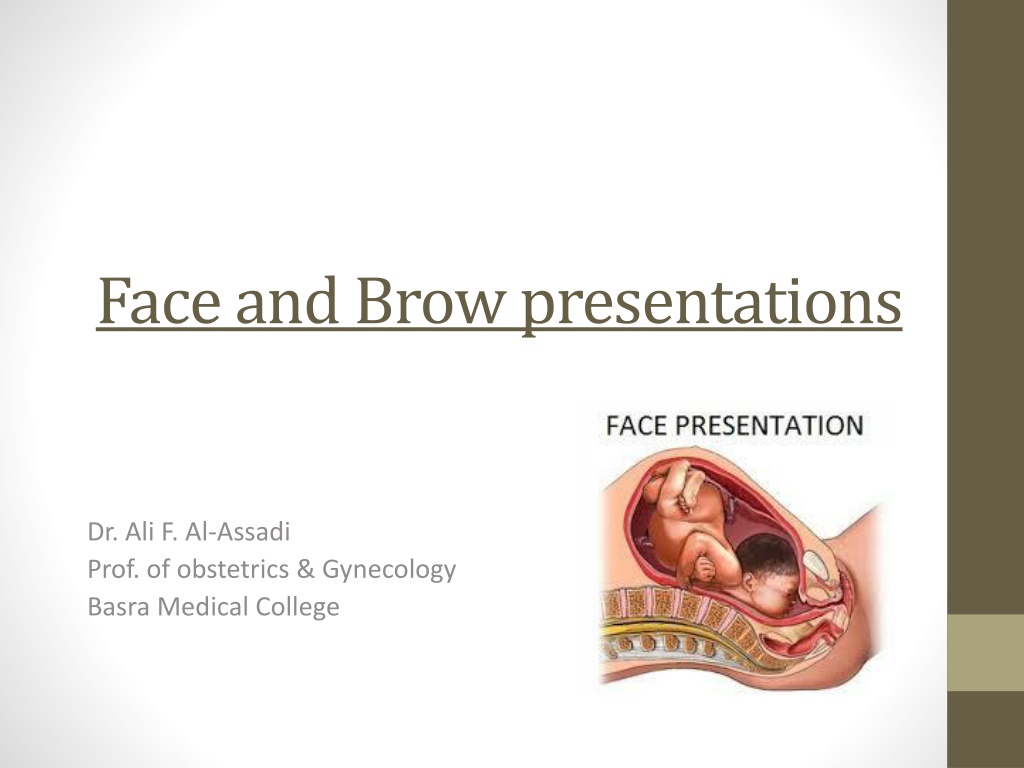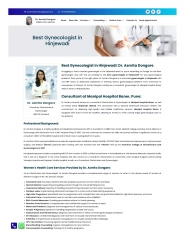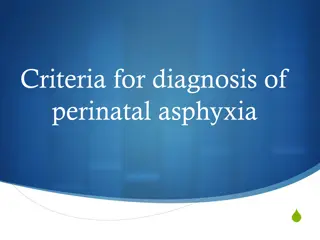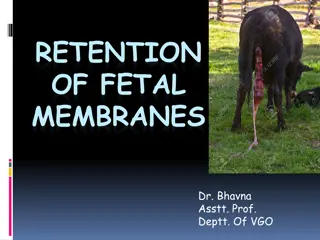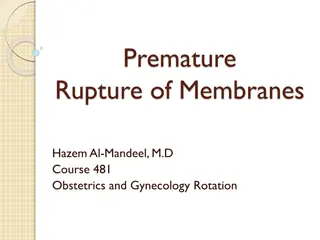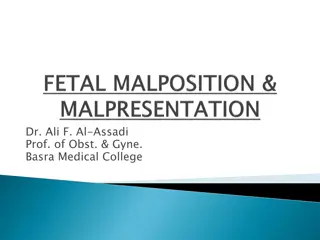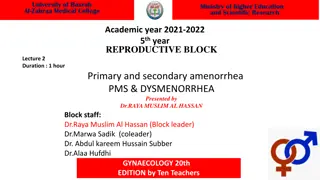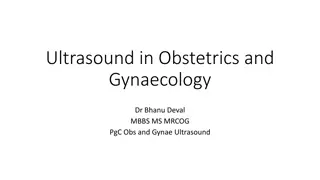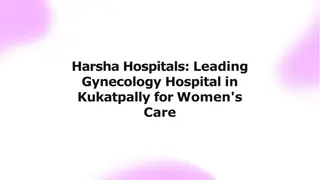Understanding Face and Brow Presentations in Obstetrics & Gynecology
Face and brow presentations are rare occurrences in labor, with causes varying from fetal positioning to maternal factors. Diagnosis involves abdominal and vaginal examinations, with management strategies including cesarean section in certain cases. Understanding the mechanisms and diagnosis of these presentations is crucial for appropriate obstetric care.
Download Presentation

Please find below an Image/Link to download the presentation.
The content on the website is provided AS IS for your information and personal use only. It may not be sold, licensed, or shared on other websites without obtaining consent from the author. Download presentation by click this link. If you encounter any issues during the download, it is possible that the publisher has removed the file from their server.
E N D
Presentation Transcript
Face and Brow presentations Dr. Ali F. Al-Assadi Prof. of obstetrics & Gynecology Basra Medical College
Face presentation; Occur 1:300-500 deliveries. Causes: A- primary: (before the onset of labor) 1. The most common is normal fetus actively holds its head extended ( in 50% of cases). 2. Anencephaly. 3. Prematurity. 4. Contracted pelvis. 5. Multiple pregnancies. 6. Cord around neck or neck tumors. 7. Polyhydramnios. 8. Multiparity. B-Secondary: (the commonest) arise during labour eg. Extension of brow to face.
Mechanism of labour: The chin is the denominator & 4 positions are described (L & R mentoanterior 75%, L & R mentoposterior). In mentoanterior the head engages & descends with increasing extension so that the Submentobregmatic diameter ( 9.5 cm) comes through the cervix when the chin reaches the pelvic floor it undergoes internal rotation through 1/8 of a circle & the sub mental region comes to lie under the sub pubic arch, the head is born by a movement of flexion , the rest of the mechanism is as in vertex presentation.
Mechanism of labour: In mentoposterior position a similar mechanism occur except that the chin has to undergo internal rotation through 3/8 of a circle. Persistent mentoposterior position cannot be delivered unless the fetus is very small, this is because the head is already fully extended & further extension is impossible.
Diagnosis : Abdominal examination Mentoposterior: the cephalic prominence is easily felt overlapping the symphysis on the same side as the back from which it is separated by a deep sulcus. Mentoanterior : the cephalic prominence is difficult to be felt because it is directed posteriorly. Fetal heart is easily heard over the chest than in mentoposterior position.. Ultrasound in labor may be helpful.
Diagnosis : Vaginal examination: The membranes ruptured early in labor. Supraorbital ridges, the bridge of the nose & the alveolar margins within the mouth are recognized. If the face is edematous it can be mistaken for the breech.
Management Fetal abnormality & contracted pelvis must be excluded. CS is indicated in: 1. Old age primigravida. 2. Bad obstetric history. 3. Infertility. 4. Scared uterus. 5. PE 6. placenta previa. 7. Fetal weight > 3.5 kg. Epidural anesthesia or perineal infiltration is important for episiotomy or instrumental delivery.
In mentoanterior observe for spontaneous delivery if there is delay in the 2ndstage forceps delivery may be attempted. Vacuum extractor is totally contraindicated. In mentoposterior allow a time for spontaneous rotation which usually occur late in the 2ndstage, if rotation does not occur it can be helped by manual rotation to mentoanterior position under epidural anesthesia or GA & delivery is completed with forceps. Failure of this is an indication for CS.
Brow presentation Occur 1:1000 deliveries. Many brow presentations early in labour are transient proceeding to full deflexion or alternatively undergoing spontaneous flexion & correction to vertex.
Mechanism of labour: If a head of normal size lies with its longest diameter of 13 cm across the brim of normal pelvis it cannot engages & obstructed labour result. However, when the fetal head is quit small in proportion to the pelvis it may be engaged & born in brow presentation. Occasionally following engagement, spontaneous correction to vertex or face occur in the pelvis.
Diagnosis: Abdominal examination: the head is above the brim, with some overlap & the cephalic prominence is on the same side as the back. The head feels larger from side to side. Vaginal examination: the membranes rupture early in labour with risk of cord prolapse, the presenting part is high & the forehead , with the orbital ridges & bridge of the nose in front & the anterior fontanel can be felt with the examining finger. Abdominal ultrasound.
Management: If diagnosed during the antenatal period congenital malformations & CPD should be excluded otherwise nothing should be done, as in most cases the head will flex when labour starts & spontaneous delivery will occur. If diagnosed early in labour & there is no evidence of severe CPD short trial of labour is permitted & this may results in further extension of the head to face presentation & engagement. If the head fails to engage or persistent brow presentation or if there is evidence of disproportion a CS is performed, which is done if fetal distress develop in labour.
